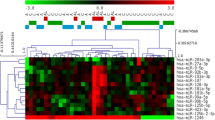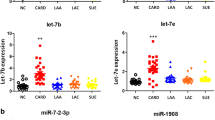Abstract
The aims of the study were (1) to determine whether miRNAs (microRNAs) can be detected in the cerebrospinal fluid (CSF) and blood of patients with ischemic stroke and (2) to compare these miRNA profiles with corresponding profiles from other neurological patients to address whether the miRNA profiles of CSF or blood have potential usefulness as diagnostic biomarkers of ischemic stroke. CSF from patients with acute ischemic stroke (n = 10) and patients with other neurological diseases (n = 10) was collected by lumbar puncture. Blood samples were taken immediately after. Expression profiles in the cell-free fractions of CSF and blood were analyzed by a microarray technique (miRCURY LNA™ microRNA Array, Exiqon A/S, Denmark) using a quantitative PCR (qPCR) platform containing 378 miRNA primers. In total, 183 different miRNAs were detected in the CSF, of which two miRNAs (let-7c and miR-221-3p) were found upregulated in relation to stroke. In the blood, 287 different miRNAs were detected of which two miRNAs (miR-151a-3p and miR-140-5p) were found upregulated and one miRNA (miR-18b-5p) was found downregulated in the stroke group. Some miRNAs occurred exclusively in the CSF including miR-523-3p which was detected in 50 % of the stroke patients, whereas it was completely absent in controls. Our preliminary results demonstrate that it is possible to detect and profile miRNAs in CSF and blood from patients with neurological diseases. Some miRNAs appear differentially expressed in the CSF and others in the blood of stroke patients. Currently, we are validating our results in larger groups of patients.


Similar content being viewed by others
References
Christensen T. Experimental focal cerebral ischemia—pathophysiology, metabolism and pharmacology of the ischemic penumbra. Thesis from University of Copenhagen; 2007. ISBN: 9788799213801.
Hossmann K-A. Pathophysiology and therapy of experimental stroke. Cell Mol Neurobiol. 2006;26:1057–83.
Schmidt-Kastner R, Zhang B, Belayev L, Khoutorova L, Amin R, Busto R, et al. DNA microarray analysis of cortical gene expression during early recirculation after focal brain ischemia in rat. Brain Res Mol Brain Res. 2002;108:81–93.
Friedman RC, Farh KK-H, Burge CB, Bartel DP. Most mammalian mRNAs are conserved targets of microRNAs. Genome Res. 2009;19:92–105.
Homo sapiens miRNAs in the miRBase at Manchester University. http://www.mirbase.org.
Li MA, He L. MicroRNAs as novel regulators of stem cell pluripotency and somatic cell reprogramming. BioEssays. 2012;34:670–80.
Gauthier BR, Wollheim CB. MicroRNAs: “ribo-regulators” of glucose homeostasis. Nat Med. 2006;12:36–8.
Chan JA, Krichevsky AM, Kosik KS. MicroRNA-21 is an antiapoptotic factor in human glioblastoma cells. Cancer Res. 2005;65:6029–33.
Bi Y, Liu G, Yang R. MicroRNAs: novel regulators during the immune response. J Cell Physiol. 2009;218:467–72.
Krichevsky AM, King KS, Donahue CP, Khrapko K, Kosik KS. A microRNA array reveals extensive regulation of microRNAs during brain development. RNA. 2003;9:1274–81.
Sempere LF, Freemantle S, Pitha-Rowe I, Moss E, Dmitrovsky E, Ambros V. Expression profiling of mammalian microRNAs uncovers a subset of brain-expressed microRNAs with possible roles in murine and human neuronal differentiation. Genome Biol. 2004;5:R13.
Jeyaseelan K, Lim KY, Armugam A. MicroRNA expression in the blood and brain of rats subjected to transient focal ischemia by middle cerebral artery occlusion. Stroke. 2008;39:959–66.
Liu FJ, Lim KY, Kaur P, Sepramaniam S, Armugam A, Wong PTH, et al. MicroRNAs involved in regulating spontaneous recovery in embolic stroke model. PLoS One. 2013;8:e66393.
Liu D-Z, Tian Y, Ander BP, Xu H, Stamova BS, Zhan X, et al. Brain and blood microRNA expression profiling of ischemic stroke, intracerebral hemorrhage, and kainate seizures. J Cereb Blood Flow Metab. 2010;30:92–101.
Ziu M, Fletcher L, Rana S, Jimenez DF, Digicaylioglu M. Temporal differences in microRNA expression patterns in astrocytes and neurons after ischemic injury. PLoS One. 2011;6:e14724.
Lim K-Y, Chua J-H, Tan J-R, Swaminathan P, Sepramaniam S, Armugam A, et al. MicroRNAs in cerebral ischemia. Transl Stroke Res. 2010;1:287–303.
Dharap A, Bowen K, Place R, Li L. Translational focal ischemia induces extensive temporal changes in rat cerebral MiroRNAome. J Cereb Blood Flow Metab. 2009;29:675–87.
Tan KS, Armugam A, Sepramaniam S, Lim KY, Setyowati KD, Wang CW, et al. Expression profile of microRNAs in young stroke patients. PLoS One. 2009;4:e7689.
Cogswell JP, Ward J, Taylor IA, Waters M, Shi Y, Cannon B, et al. Identification of miRNA changes in Alzheimer’s disease brain and CSF yields putative biomarkers and insights into disease pathways. J Alzheimers Dis. 2008;14:27–41.
Alexandrov PN, Dua P, Hill JM, Bhattacharjee S, Zhao Y, Walter J. MicroRNA (miRNA) speciation in Alzheimer’s disease (AD) cerebrospinal fluid (CSF) and extracellular fluid (ECF). Int J Biochem Mol Biol. 2012;3:365–73.
Pacifici M, Delbue S, Ferrante P, Jeansonne D, Kadri F, Nelson S, et al. Cerebrospinal fluid miRNA profile in HIV-encephalitis. J Cell Physiol. 2013;228:1070–5.
Baraniskin A, Kuhnhenn J, Schlegel U, Chan A, Deckert M, Gold R, et al. Identification of microRNAs in the cerebrospinal fluid as marker for primary diffuse large B-cell lymphoma of the central nervous system. Blood. 2011;117:3140–6.
Baraniskin A, Kuhnhenn J, Schlegel U, Maghnouj A, Zöllner H, Schmiegel W, et al. Identification of microRNAs in the cerebrospinal fluid as biomarker for the diagnosis of glioma. Neuro-Oncol. 2012;14:29–33.
Baraniskin A, Kuhnhenn J, Schlegel U, Schmiegel W, Hahn S, Schroers R. MicroRNAs in cerebrospinal fluid as biomarker for disease course monitoring in primary central nervous system lymphoma. J Neuro-Oncol. 2012;109:239–44.
Teplyuk NM, Mollenhauer B, Gabriely G, Giese A, Kim E, Smolsky M, et al. MicroRNAs in cerebrospinal fluid identify glioblastoma and metastatic brain cancers and reflect disease activity. Neuro-Oncol. 2012;14:689–700.
Haghikia A, Hellwig K, Baraniskin A, Holzmann A, Décard BF, Thum T. Regulated microRNAs in the CSF of patients with multiple sclerosis. Neurology. 2012;79:2133–70.
Gallego JA, Gordon ML, Claycomb K, Bhatt M, Lencz T, Malhotra AK. In vivo microRNA detection and quantitation in cerebrospinal fluid. J Mol Neurosci. 2012;47:243–8.
Adams HP, Bendixen BH, Kappelle LJ, Biller J, Love BB, Gordon DL, et al. Classification of subtype of acute ischemic stroke. Definitions for use in a multicenter clinical trial. TOAST. Trial of Org 10172 in Acute Stroke Treatment. Stroke. 1993;24:35–41.
Reiber H, Peter JB. Cerebrospinal fluid analysis: disease-related data patterns and evaluation programs. J Neurol Sci. 2001;184:101–22.
Andersen CL, Jensen JL, Ørntoft TF. Normalization of real-time quantitative reverse transcription-PCR data: a model-based variance estimation approach to identify genes suited for normalization, applied to bladder and colon cancer data sets. Cancer Res. 2004;64:5245–50.
Pfaffl MW. Quantification strategies in real-time PCR. In: Bustin SA, editor. A-Z of quantitative PCR. La Jolla: International University Line; 2004. p. 89–120.
Reiber H, Peter JB. Cerebrospinal fluid analysis: disease-related data patterns and evaluation programs. J Neurorodiol Sci. 2001;184:101–22.
Liu X, Cheng Y, Zhang S, Lin Y, Yang J, Zhang C. A necessary role of miR-221 and miR-222 in vascular smooth muscle cell proliferation and neointimal hyperplasia. Circ Res. 2009;104:476–87.
Zhang Q, Kandic I, Kutryk MJ. Dysregulation of angiogenesis-related microRNAs in endothelial progenitor cells from patients with coronary artery disease. Biochem Biophys Res Commun. 2011;405:42–6.
Wang Y-T, Tsai P-C, Liao Y-C, Hsu C-Y, Juo S-HH. Circulating microRNAs have a sex-specific association with metabolic syndrome. J Biomed Sci. 2013;20:72.
Valadi H, Ekström K, Bossios A, Sjöstrand M, Lee JJ, Lötvall JO. Exosome-mediated transfer of mRNAs and microRNAs is a novel mechanism of genetic exchange between cells. Nat Cell Biol. 2007;9:654–9.
Wang K, Zhang S, Weber J, Baxter D, Galas DJ. Export of microRNAs and microRNA-protective protein by mammalian cells. Nucl Acids Res. 2010;38:7248–59.
Hata R, Gillardon F, Michaelidis TM, Hossmann KA. Targeted disruption of the bcl-2 gene in mice exacerbates focal ischemic brain injury. Metab Brain Dis. 1999;14:117–24.
Gregersen R, Lambertsen K, Finsen B. Microglia and macrophages are the major source of tumor necrosis factor in permanent middle cerebral artery occlusion in mice. J Cereb Blood Flow Metab. 2000;20:53–65.
Kinouchi H, Sharp FR, Hill MP, Koistinaho J, Sagar SM, Chan PH. Induction of 70-kDa heat shock protein and hsp70 mRNA following transient focal cerebral ischemia in the rat. J Cereb Blood Flow Metab. 1993;13:105–15.
Christensen T, Jørgensen MB, Diemer NH. Impairment of Fos protein formation in the rat infarct borderzone by MK-801, but not by NBQX. Acta Neurol Scand. 1993;87:510–5.
Shi B, Guo Y, Wang J, Gao W. Altered expression of microRNAs in the myocardium of rats with acute myocardial infarction. BMC Cardiovasc Disord. 2010;10:11.
Ortega FJ, Mercader JM, Moreno-Navarrete JM, Rovira O, Guerra E, Esteve E, et al. Profiling of circulating microRNAs reveals common microRNAs linked to type 2 diabetes that change with insulin sensitization. Diabetes Care. 2014;37:1375–83.
Acknowledgments
This project was supported by grants from the Research Foundation of Nordsjællands Hospital, Copenhagen University; the Research Foundation for Health Research of the Capital Region of Denmark; Helen Rude’s Foundation, Dagmar Marshall’s Foundation, and the Foundation of Lily Benthine Lund.
Compliance with Ethics Requirements
ᅟ
Conflict of Interest
All the authors declare that they have no conflicts of interest.
Ethical approval
All project procedures were approved by the Danish Research Ethics Committee (project ID: H-1-2011-094) and were in accordance with the Helsinki Declaration of 1975, as revised in 2008. Informed consent was obtained from all patients prior to inclusion. Patients did not receive any fee for participation in the study.
Author information
Authors and Affiliations
Corresponding author
Electronic supplementary material
Below is the link to the electronic supplementary material.
Online Resource 1
Regulation of the 144 most frequently detected miRNAs in plasma of acute ischemic stroke patients (DOC 206 kb)
Online Resource 2
Estimation of the blood brain barrier function in neurological patients based on albumin CSF/serum concentration quotients (DOC 69 kb)
Online Resource 3
Additional information on the patients included: symptoms and deficits, stroke severity, radiological findings and risk factors for ischemic stroke (DOC 58 kb)
Rights and permissions
About this article
Cite this article
Sørensen, S.S., Nygaard, AB., Nielsen, MY. et al. miRNA Expression Profiles in Cerebrospinal Fluid and Blood of Patients with Acute Ischemic Stroke. Transl. Stroke Res. 5, 711–718 (2014). https://doi.org/10.1007/s12975-014-0364-8
Received:
Revised:
Accepted:
Published:
Issue Date:
DOI: https://doi.org/10.1007/s12975-014-0364-8




